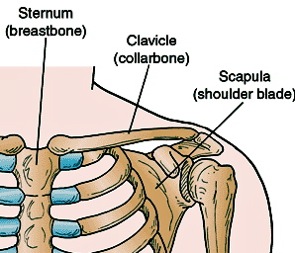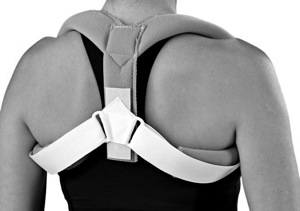HOW TO RETURN FROM A BROKEN COLLARBONE:

The collarbone is the most commonly broken bone in the human body, and understandably so when you consider that it only takes seven pounds of pressure to break it. In the world of motocross, there are two kinds of riders-those who have broken their collarbones and those who will. Collarbones are usually broken by falling on the point of the shoulder, impacting the ground with your upper torso or hitting the ground hard with one arm above your head.
CATEGORIZING COLLARBONE BREAKS

There are four kinds of broken collarbones:
(1) Cracked (the least of the worst);
(2) Splintered (typically lengthwise);
(3) Broken (as in two pieces);
(4) Compound (ouch).
If you suspect that you have broken your collarbone, then you probably cracked it or even splintered it. If you broke it in two pieces, you’ll know by the intense pain, drooping shoulder and lump on your chest. We don’t have to tell you how to identify a compound fracture?it’s evident in the face of the first person to look at it.
Try not to ironman your way through a collarbone incident?go to the hospital, get an X-ray and do what the doctor tells you. The standard practice for a clean break is pain pills and a shoulder harness to draw the shoulders back so that the bones (previously a bone) will align. If you’ve ever worn a collarbone harness, you know how irritating it can be. Your doctor will recommend that you wear the harness until the bones are healed-but few racers have ever worn a collarbone harness for the full term.
WHAT IF IT’S REALLY BROKEN?
If the bone is broken in two and the ends overlap each other, the doctor will try to use the harness to pull the two ends back into their proper alignment. This sometimes entails him putting his knee in your back and tugging. If that fails, he might suggest surgery to pin the bones. You may fear surgery, but overlapping collar bones can cause serious biomechanical maladjustments which could affect your strength and range of motion. Listen to your doctor, get a second opinion if you have doubts, but do everything in your power to get the bones to line up properly.
The surgery consists of using screws and a metal plate to reattach the bones. It leaves a scar and a lump. Not attractive, but fully functional in time. Given our druthers, we’d prefer to have the bones heal sans nuts and bolts.

HOW LONG WILL IT TAKE TO HEAL?
That depends. A crack will heal faster than a break. A young rider will heal faster than an older one. Perfectly aligned ends heal faster than misaligned ones. It’s important to understand that every body is unique. Don’t rush the healing process just because Johnny Gofast said he was back racing three weeks after breaking his collarbone. Bones don’t weld together. In fact, they heal by having a bridge of calcium form across the gap of the two bones. The smaller the gap, the faster the bridge will form.
So, how long will it take to heal? Six weeks is the standard answer.
THE WONDERS OF CALCIUM
The calcium bridge is quite unique.
(1) As the calcium forms in the break, it sometimes works overtime and produces a pronounced bump. That bump can be so large that it gets irritated, red and welt-like. Have no fear, the bum
(2) During the healing process, typically between three to five weeks, the calcium bridge is mushy. Although it has bridged the gap, it has not solidified yet. Falling down, getting jostled or not wearing the harness can make the bones move. Be forewarned that disturbing the mushy calcium will slow down the healing process.
(3) X-rays can reveal how fast the bone is healing. The calcium can be seen on the X-ray and the doctor can use this to judge the progress of the healing.
MXA’S COLLARBONE TIPS AND TRICKS
The MXA wrecking crew can’t fix your collarbone for you, but we can tell you how to get back in action faster. Here are our tips (learned through experience).

Collarbone bra: We suggest that you wear the shoulder brace. The brace is meant to hold the bones in the best position to heal-not just heal properly, but heal faster (by narrowing the gap the calcium bridge has to span). We hate the brace as much as anyone, but poorly aligned shoulders cause muscle imbalance, which at the very least will make you paddle your surfboard in a circle.
Rush to weakness: Don’t try to rush back into action. Let it heal! If you continue to move the mushy calcium around before it has had time to, dare we say it, calcify, you could end up with an extra joint that isn’t in Gray’s Anatomy. Collarbones that don’t heal properly lose their ability to knit back together. Not pleasant.
Take the radiation: Don’t skip the X-rays. Always insist that the doctor take an X-ray before releasing you to race again. It is possible to feel strong, have excellent mobility and believe that you are healed, but not be. An X-ray will reveal if the bones are solidly attached. If they aren’t, give them a week or two-otherwise they could re-break over the first whoop.
Go to the gym: Ever heard of the dumbbell shrug? Once your doctor says that your collarbone is healed, get to the gym and start working out. Start with no weight (just the bar) and do dumbbell shrugs, upright rows and behind-the-neck presses. Start slowly and work your way through light weights to heavier weights. Don’t do more than three sets of 12 reps. The goal isn’t to build bulging muscles but to increase movement, flexibility and strength. Add more weight as you get stronger, but don’t increase the reps or sets.
Buy shoulder pads: Listen and listen good! Shoulder pads cannot prevent a broken collarbone, but the first question that every rider who breaks his collarbone is asked is, “Were you wearing shoulder pads?” When you say, “No,” people shake their heads and walk away. While it is true that shoulder pads are no guarantee against a broken collarbone, they do dissipate the blow, spread out the energy and might be able to turn a compound fracture into a break, a break into a splinter or a splinter into a crack. We promise you that the lesser of the collarbone evils is worth wearing a plastic shirt.





Comments are closed.